Recipe: Original Sifnos Chickpea Stew (Revithada) in a...
The signature dish of the island...
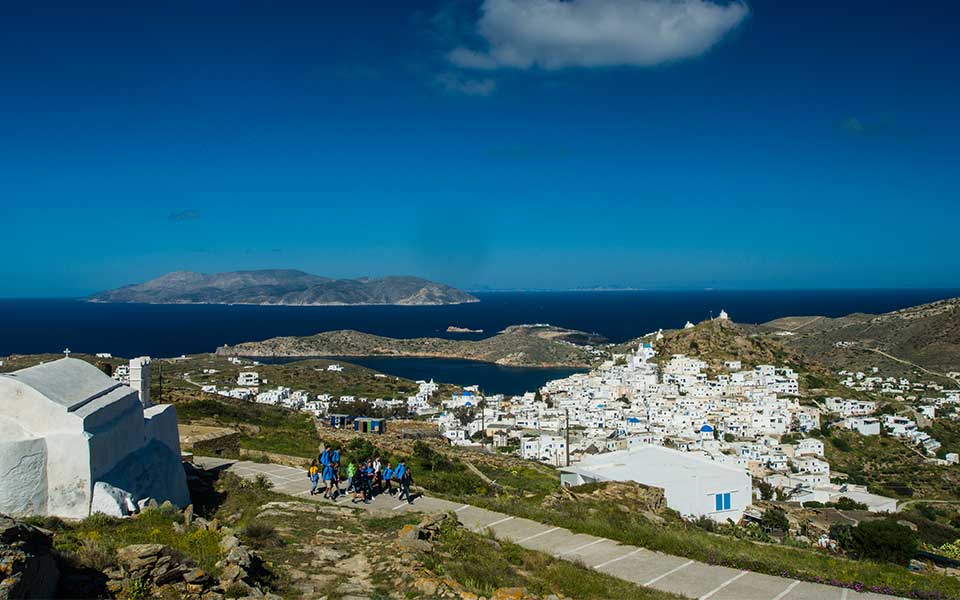
Ios
© Clairy Moustafellou
Over the years, Ios has revealed many different faces to many different types of traveler. Once a hippie haven in the 1970s, it then developed to become a hedonistic party hotspot beloved by teens and twenty-somethings from around the world. Today, however, the island is reestablishing itself as an authentic, luxury destination with a new wave of innovative and elegant hotels, resorts, spas and restaurants, and a newfound respect for its rich cultural heritage.
Yet, throughout its many transformations, Ios has always managed to hold onto its own identity while offering something for everyone. So, perhaps we shouldn’t be talking about the many faces of Ios — but the one timeless face that welcomes all those who set foot on her shores.
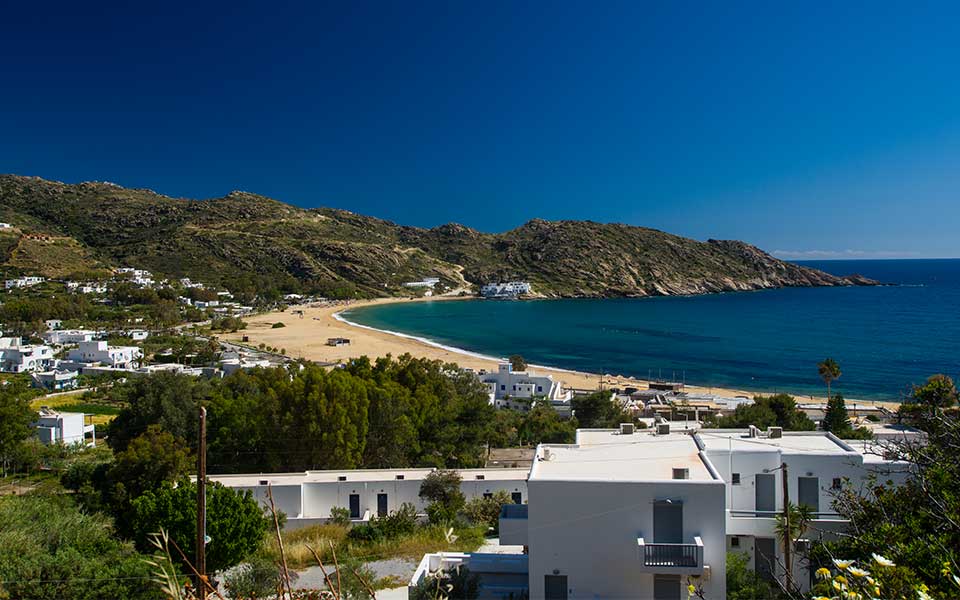
Mylopotas Beach
© Clairy Moustafellou
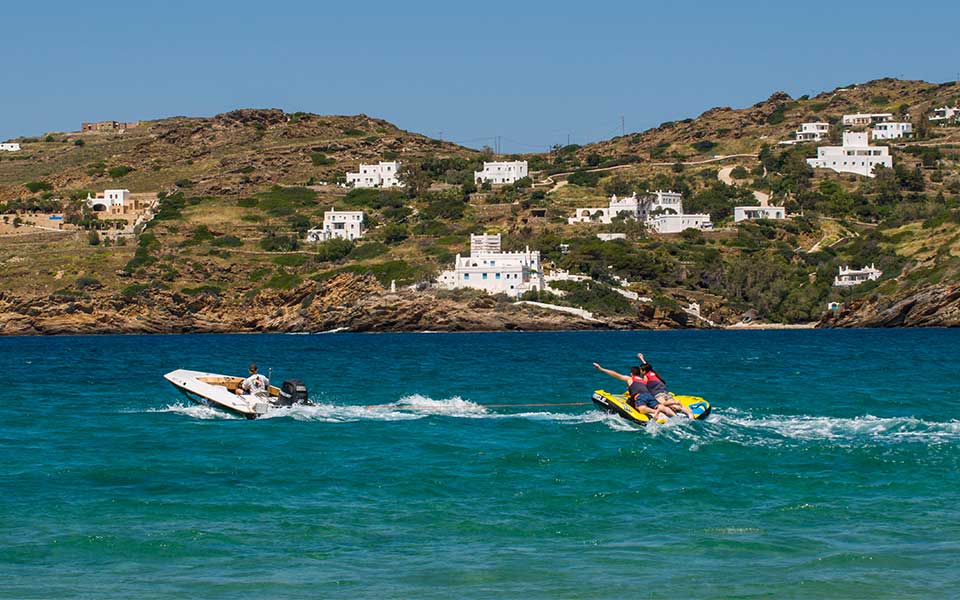
Mylopotas
© Clairy Moustafellou
When Peter Bramwell from the UK arrived on Mylopotas Beach in 1978, it was still a hippie haven. “I remember sleeping on the beach that first night,” Peter says. “There were hardly any facilities here, not even a proper road down to the beach. But for the people who made the island their home for the summer, there was a wonderful sense of freedom and fun.”
In order to stay, Peter founded Meltemi right on Mylopotas Beach in 1986. As tourism has boomed on Ios and holiday resorts have sprung up all along the waterfront, his business has grown to twelve boats and twenty staff in the high season, offering everything from windsurfing to stand-up-paddle boarding and yoga.
Peter has long been fascinated by the millenia-old culture of the Cyclades, and when he felt there was enough demand, he started offering history tours of Ios’ storied Hora. And he is just is one of many whose time on Ios began in the hippie era, but who now run businesses that are helping shape the island’s new image.
Ios Hora
© Clairy Moustafellou
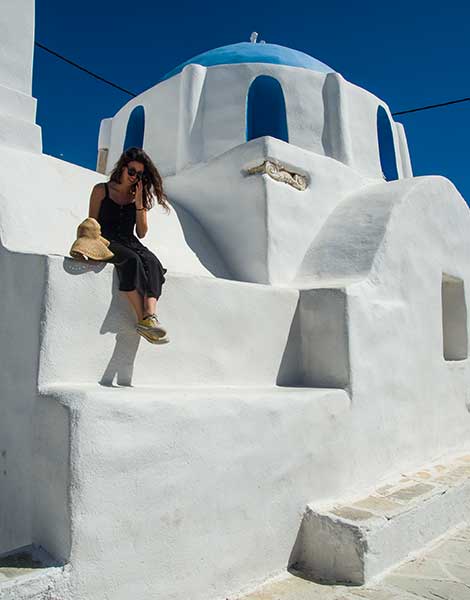
Ios Hora
© Clairy Moustafellou
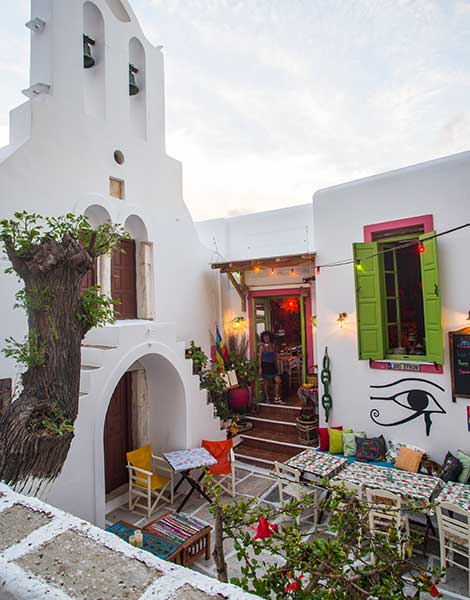
Ios Hora
© Clairy Moustafellou
Every Wednesday, you can find Irishman Robbie Fitzrobert waiting outside the Archaeological Museum on the main road that runs below Hora. One of the most picturesque Horas in the Cyclades, it climbs up a hill above the port and is topped with three Orthodox chapels and overlooked by a string of windmills.
Robbie’s vivid and throughly researched history walks are the best way to get up to speed on the town’s history and that of the island as a whole. He traces a story from the first settlement around the safe natural harbor in the prehistoric era, through the many great empires who all left their mark on the island, from the Minoans to the Romans, Venetians and Ottomans.
Robbie has been coming to Ios since 1979 and is bursting with stories that bring the island’s past and its connection to the wider region’s history to life; like pointing out the former home of Jean Parisot de La Valette, a 16th-century French nobleman who fought the Ottomans at Malta, whose capital Valletta is named in his honour. Or leading us along Armstrong, Aldrin and Collins Street, named in tribute to the astronauts who landed on the moon in 1969 — just three years after Ios was electrified.
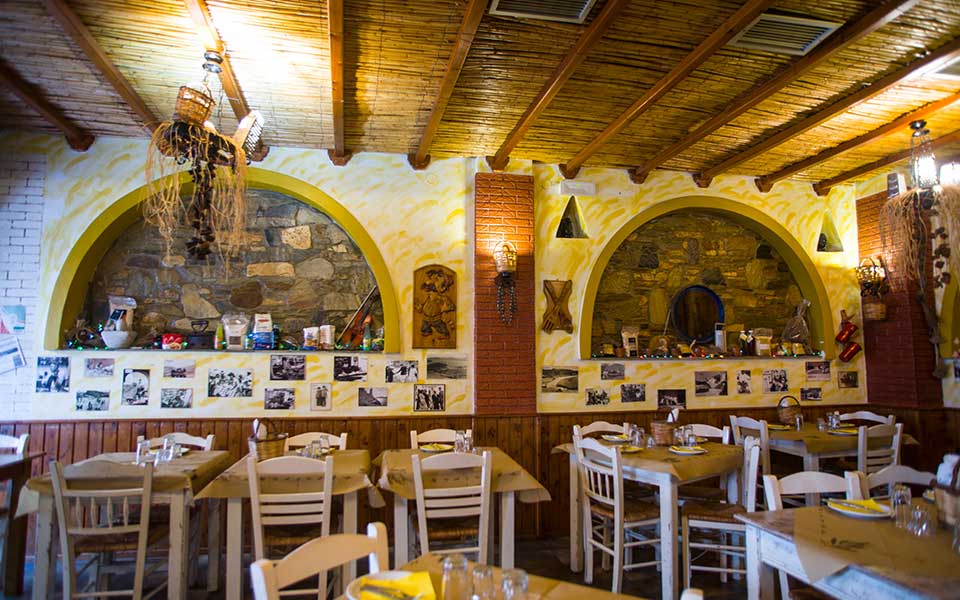
Sainis restaurant
© Clairy Moustafellou
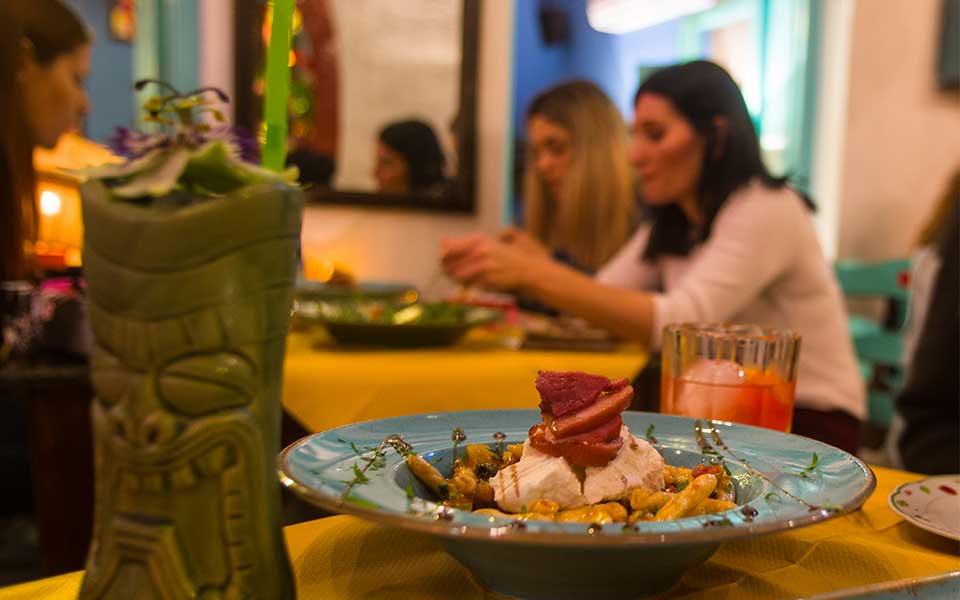
Katogi restaurant
© Clairy Moustafellou
Away from the beaten track, we stop at the quiet, family-run Sainis taverna, to rest with a glass of wine. Here, Robbie shares more of his personal favourites on the island. His recommendation for dinner is Katogi, which serves up taverna fare with fresh and fun twists, and is beloved by locals and visitors alike.
Opened by Theodora Tziamali and George Katseas 14 years ago, it came as a breath of fresh air for the island’s restaurant scene. Katogi’s success has helped put Ios on the culinary map and inspired others to depart from the predictable staples, to be original and raise standards. Spilling out into the courtyard of an old ouzeri in the centre of Hora, bright passion flowers hang overhead — which find their way into the Mexican Passion cocktail.
The intimate and playful atmosphere of the restaurant is echoed on the menu too, with spectacularly presented dishes like the roasted vegetable salad with traditional Cretan skioufihta pasta, local cheese from Ios and apaki from Crete. Open Easter to October, make sure you book a table as Katogi is always in high demand, and pick up a copy of the Katogi cookbook as you leave.
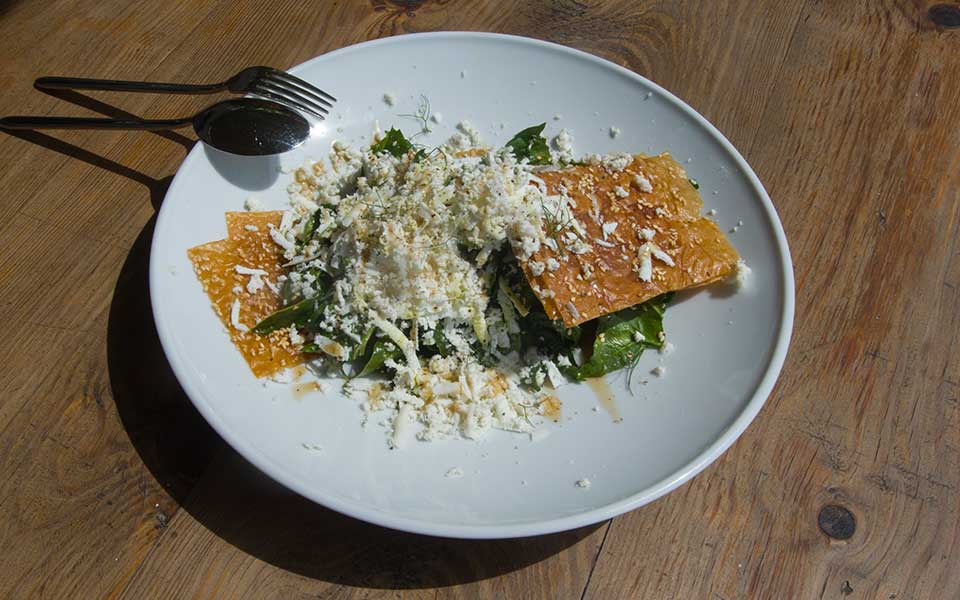
Ithaca restaurants
© Clairy Moustafellou
Beneath Hora, on the edge of the port, lies Ithaka, one of the newest and most impressive restaurants on the island. Opened in 2018 by chef Dionisis Halaj and his family, the concept is inspired by Homer — whose tomb some believe to lie on the rugged northern end of the island — and means coming back to your roots; bringing home all the cultural (and culinary) inspirations you have picked up along your journey.
Just like Odysseus, the hero of Homer’s Odyssey, Dionisis travelled far and wide; he worked in exclusive restaurants in Paris, London and Ios, before choosing to serve up high-quality and creative food on the island at a price accessible to all.
“Our customers increasingly want to sample and learn about the local produce,” Dionisis explains. “The local cheese and honey from Ios are of a very high standard because of the richness of the herbs on the island. Ios’ new winery does really great work and the wine is high quality. I enjoy working with ingredients from Ios and the surrounding area to give our guests a great experience of the local cuisine.”
Sainis Taverna (Hora, Tel. (+30) 697.393.7083)
Ithaka (Port of Ios, Tel. (+30) 2286.092.184)
Agosto Ristorante-Bar (Hora, Tel. (+30) 228.609.2020)
Pathos Lounge Bar And Restaurant (Koumpara, Tel. (+30) 698.100.0122)
Grandma’s at Liostasi (Hora, Tel. (+30) 2286.092.140)
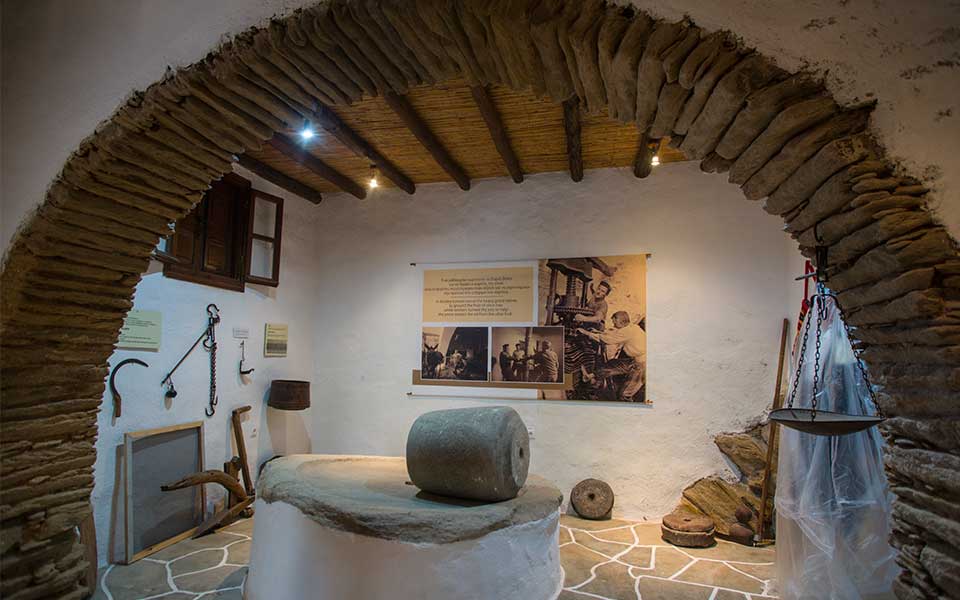
Folklore Museum
© Clairy Moustafellou
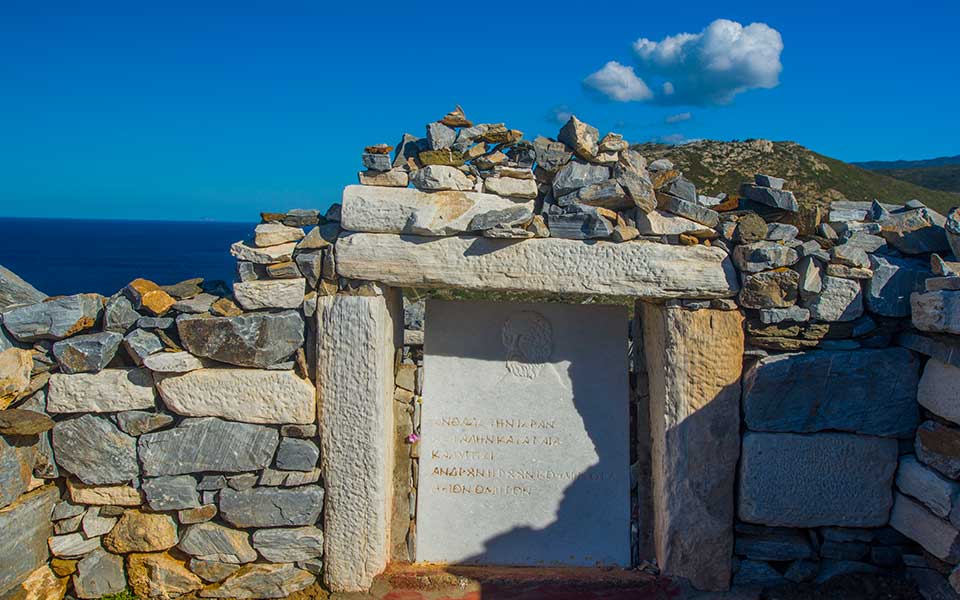
A tomb purported to be that of Homer is located on the northern coast of Ios.
© Clairy Moustafellou
The port was given a charming facelift with traditional Cycladic pebble mosaics made by Ios-born artist and author, Yiannis Loukianos in 2013. Back in the early 1970s, Yiannis ran the iconic Ios Club, which drew famous writers and musicians to the island and remains one of the best places to watch the sun set majestically over Yialos Beach and the bay beneath Hora.
Today, Yiannis’ focus is the Folk Museum, where he has spent the last three years sourcing and repairing old work tools, furniture and clothing — much from his own family’s collection — to satisfy visitors’ enthusiasm to learn more about life on the island in times gone by.
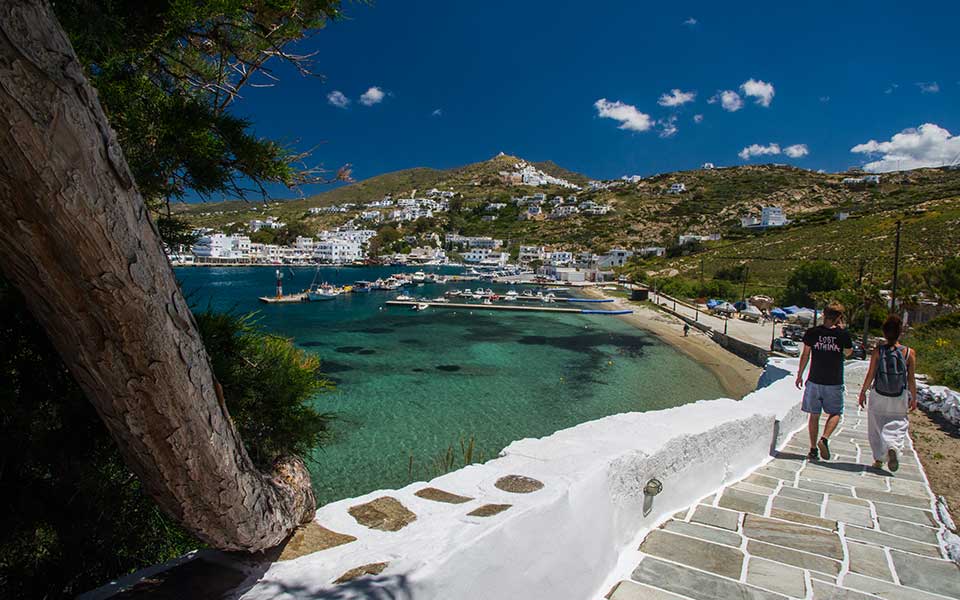
Ios port
© Clairy Moustafellou
Another artist who has long been inspired by the lifestyle and heritage of Ios is British-born painter Gail ‘Maria’ Batsalis. “I love the realism of Ios,” she explains. “I try to capture the natural beauty, romance and innocence of the island. This authenticity has remained unchanged — and visitors really appreciate it.”
Gail first came to Ios aged just 19 and is still here nearly 30 years later. In recent years, she has noticed increased interest in her work as visitors’ desire to explore the local culture has grown. Her other job, managing rental villas, has also given her insight into how tourism on the island is evolving.
Gail explains that after the onset of the crisis, islanders began looking at new ways to attract people to Ios. They decided to go back to their roots and the long-held Greek tradition of philoxenia, or hospitality; offering not just accommodation but the chance to experience Greek island life through renting out traditional local homes. This has been immensely successful, striking a chord with exactly what a new breed of travelers are looking for and helping to drive substantial growth in the number of families and older couples visiting the island.
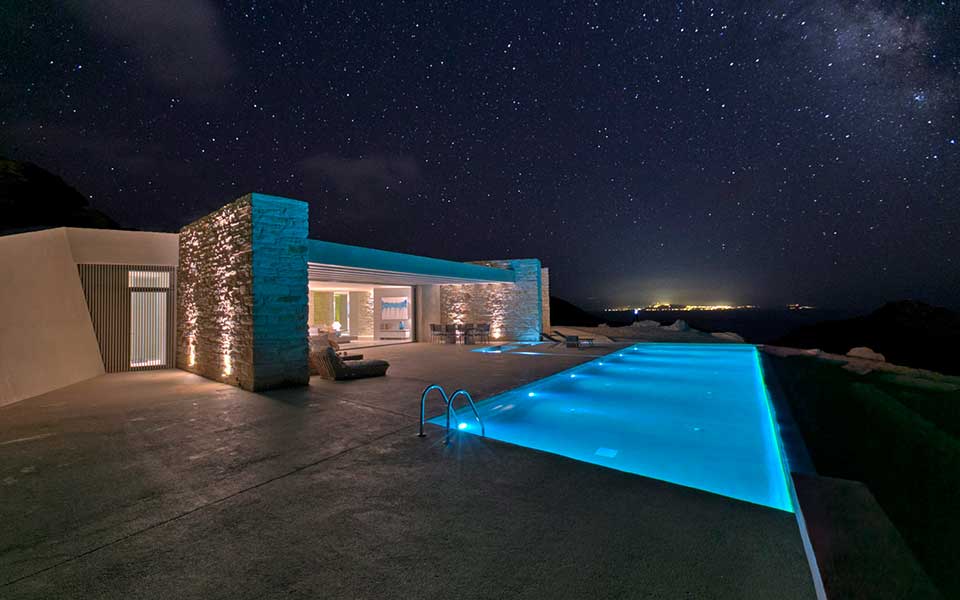
Up in the rocky and rugged hills beyond Mylopotas Beach sit three state-of-the art houses with spectacular views towards neighbouring Sikinos. But the houses themselves are barely visible from most angles. Architect Christos Vlachos’ homes are cut into the rock – inspired by the pre-Cycladic peoples who lived in naturally-ventilated caves. Unlike conventional architecture, the houses blend into the topography much like the traditional drystone terraces which follow the hilly terrain all over the Cyclades.
They have been a hit with Greek and international clients alike, who increasingly demand style with sustainability. To prove this is all possible without any sacrifice in comfort or luxury, take a dive into one of the long, striking outdoor swimming pools that seemingly float along the horizon and cast your eyes out over the spectacular bay below.
In the past, Ios often tried to be like everywhere else, serving up whatever its guests asked for, from jagerbombs to toga parties. But Vlachos’ approach is indicative of a broader trend towards working with what Ios really is, respecting its own character and proudly sharing that with visitors — who can’t seem to get enough.
Ios Palace
© Clairy Moustafellou
Back in 1984, Panos Pantazopoulos’ family were the first to imagine the future of luxury tourism on Ios and opened the island’s first four star hotel, Ios Palace, with a commanding view out over Mylopotas Beach. Panos made another bold step in 2006, when he opened Agosto, the island’s first true fine-dining restaurant, and is currently in the process of developing Ios Palace towards a five-star offering.
“Back in the early days, we were really working hard to create the demand for luxury tourism on Ios,” Panos says. “But now people are flocking to us and we have since been joined by many fantastic hotels and restaurants. I really welcome this increased competition because it will raise standards across the island; not just among the hotels, but the quality of restaurants, bars, nightlife and other services will rise, too. Today, we offer incredible value for the service and quality we provide — which you could pay two or three times more for on Mykonos or Santorini, for example.”
Agalia Luxury Suites (Tzamaria)
Calilo Luxury Resort (Papas Beach)
Ios Palace Hotel & Spa (Mylopotas)
Hideout Suites (Mylopotas beach)
Liostasi Hotel & Suites (Hora)
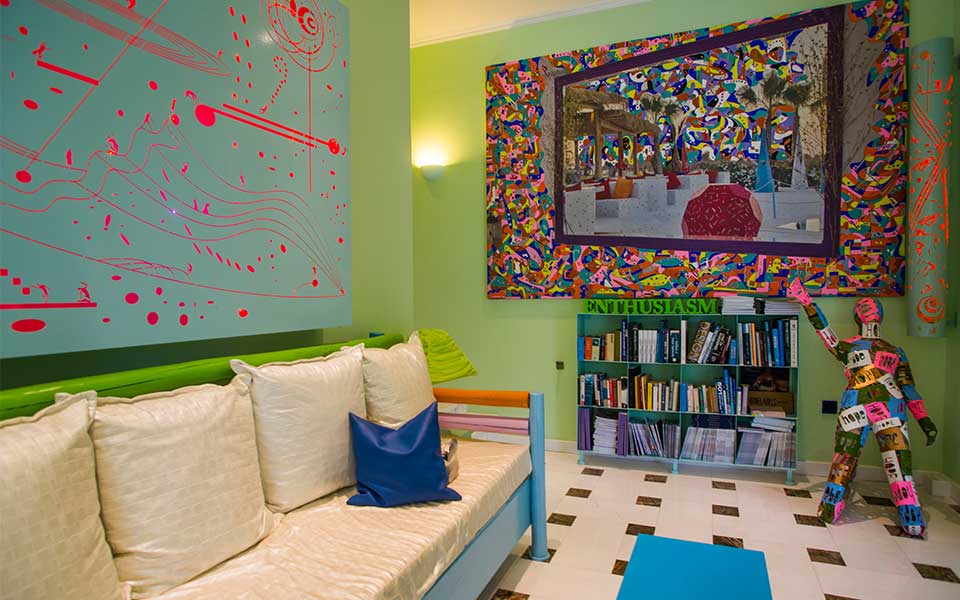
Agalia hotel

Cacilo hotel
Recently, former Wall Street trader and artist Angelos Michalopoulos has been acquiring some impressive real estate across the island and decorating the new properties with his own colorful, Gaudi-esque style; such as Agalia Luxury Suites (with its respected restaurant Taste of Joy), Pathos Sunset Bar and the ambitious Calilo, a 30-suite resort with solar power, geothermal cooling, walking trails and a private beach — which has picked up coverage from The New York Times, even before it opens fully in July this year.
Panos loves the realness of Ios and the fact that there are still remote, unspoilt beaches where you can often swim alone. His clientele are usually older than the island’s average, they want calmer places, too, and the opportunity to explore the culture, traditional buildings and natural beauty of a small island. The younger travelers who come primarily to party have always congregated around a few main areas and increasingly are concentrated in just the July high season, leaving the rest of the island — and the rest of the year — free for everyone else.
Panos believes that the lack of accessibility — there is no airport and visitors have to rely on ferries — has held the luxury tourism sector back over the years and remains the biggest barrier to continued growth. There are now plans in the works to build an airport on Ios, although there is still no completion date announced. When it is constructed, it will likely provide a considerable boost for the tourism sector, but nobody can predict the impact it will have on the island’s soul and its alluring sense of calm.
Ios today is an under-appreciated treasure. While many Greeks and foreigners still think of it as a decadent party island, locals have been making huge strides forward to offer something new, authentic and original. Standards have risen much faster than prices or visitor numbers — so now it offers a unique opportunity to enjoy a luxury Cycladic experience without too much company or an excessive price tag. But with huge investments and high-profile openings drawing more and more attention to the island, Ios’ new face likely won’t go unnoticed for long.
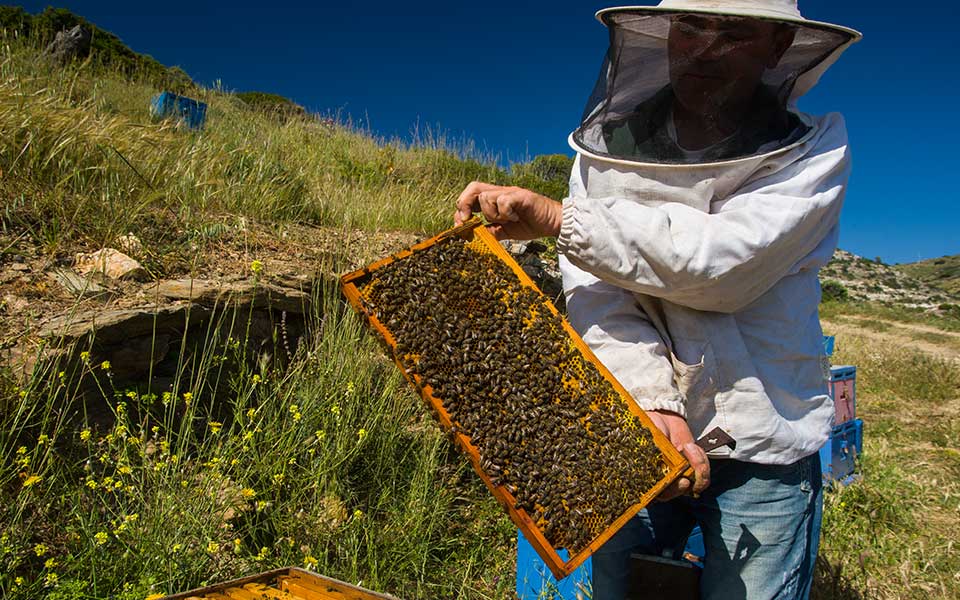
The abundant herbs on the island make Ios' products - such as its honey - exceptionally flavorful.
© Clairy Moustafellou
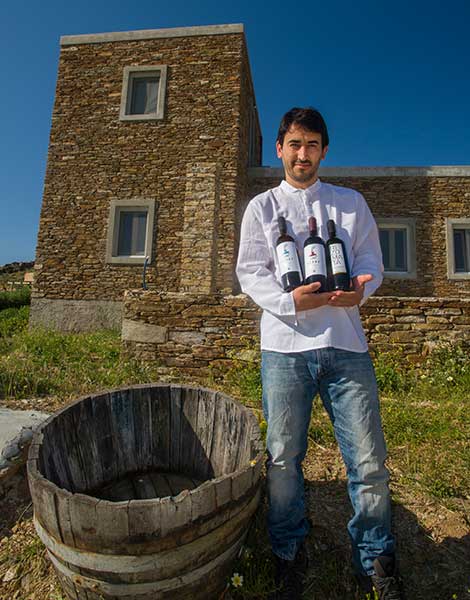
Litis wines
© Clairy Moustafellou

Niotiko cheese
© Clairy Moustafellou
Ios’ local gastronomy is an increasingly big draw for food-conscious visitors. The mountainous geography, less arid conditions and array of herbs, like throubi (summer savory) and thimari (thyme) make the island famous for its cheese throughout the Cyclades. On menus across the island, you’ll find chefs striving to give guests a taste of Ios with hard cheeses graviera and kefalotyri, and the soft skotiri and xino, which come from the Niotiko Dairy (from Nio, the locals’ alternative name for Ios) at Diaselia, (Tel. +30 2286.092.506, niotiko.gr).
– Ios’ herbs find their way into the taste of both its cheeses and flavorsome honey. Look out for the Niotiko label, from beekeeper Michalis Damvakaris (Tel. +30 6974.703.045), who lovingly calls his bees ‘girls’ and taste his light, yellow and floral Thimarisio, which comes from bees with a thyme-rich diet.
– Founded in 2015, Ios Winery (Tel. +30 6973.667.627) has small vineyards spread out across the traditional drystone terraces around the island and uses grape varieties typical of the Cyclades, like Assyrtiko and Mandilaria. The red and white Iitis labels are only available on Ios.
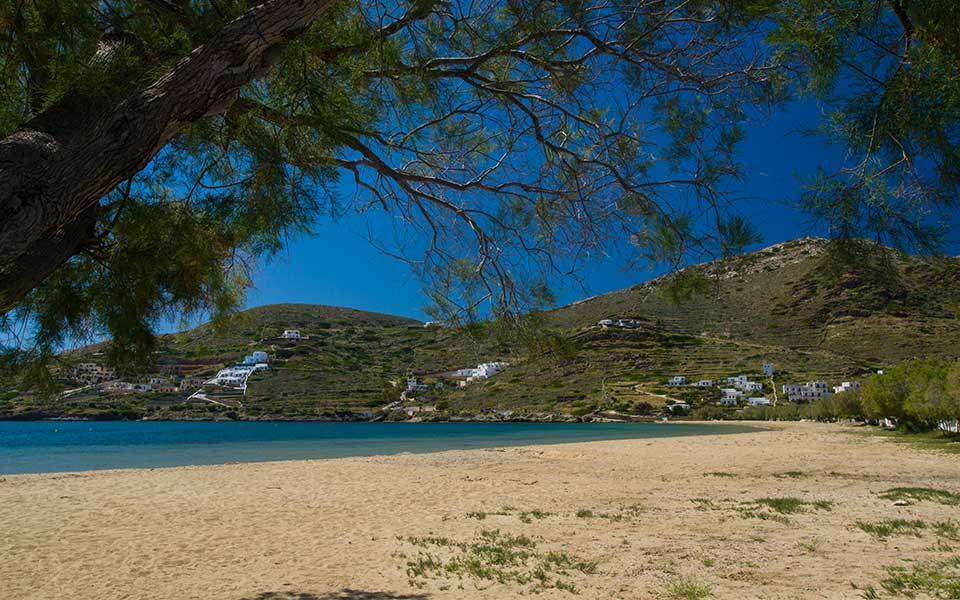
Yialos Beach
© Clairy Moustafellou
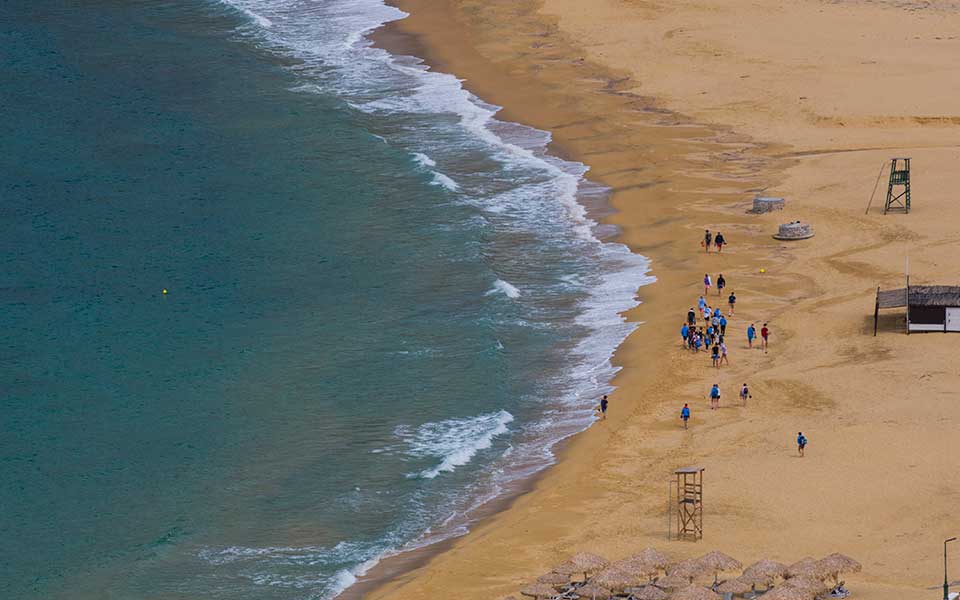
Mylopotas Beach
© Clairy Moustafellou
Mylopotas is where it all began; an expansive crescent of white sand which was once a hippie hangout and is now the most developed stretch of beach on the island, boasting everything from water sports to scooter rental and beach clubs.
Koumpara provides a beautiful view out over the water to neighbouring Sikinos and boasts umbrellas, a beach bar and a great fish taverna where you can drink, snack and dine to your heart’s content.
Tzamaria is a tiny yet picturesque slice of sand nestled among the rocks and looking out over the bay around the port.
Yialos is ‘the town beach’ and the place to go if you can’t wait to get in the water after jumping off the ferry, as it’s just a few minutes walk from the port.
Aghia Theodoti is a 20-minute drive from Hora but worth the journey if you want an unspoilt beach practically all to yourself, with (usually) free and unstaffed umbrellas — but don’t pin your hopes on finding a mojito.
From Piraeus conventional ferry boats head to Ios (from 39 euros for a one-way ticket), as do high speed vessels (from 59.90 euros for a one-way ticket). Depending on the type of vessel and route the trip takes between 4-8.5 hours. From Rafina boats take 5 hours and 40 minutes (from 45 euros for a one-way ticket). Ios does not have an airport – the nearest one is on Santorini.
The signature dish of the island...
Discover festivals, beaches, food, and hidden...
Your summer map to Ios: what...
From ancient healing sanctuaries to legendary...